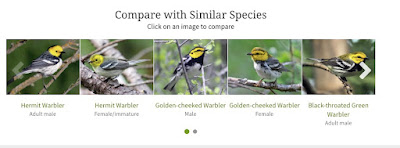A relative asked me once "So, is bird-watching basically Pokemon?" Which I interpreted to mean "Is birdwatching basically just a game of trying to find as many new and exotic birds as you can?"
At the time, I dismissed her characterization, and came up with all sorts of rationales why bird-watching is more and different than a "hunt" game. But her question made me think. Especially in Mexico, I've spent so much time getting excited about seeing birds for the first time. Is it really Pokemon after all?
Honestly, there's an element of that. There are birders who are "listers", who will make long trips to see that single species of bird that they need to complete their lists. In Huatulco, we went on a guided birding expedition with another couple, both professional biologists, who at least initially seemed more interested in seeing a single individual bird of a type that they hadn't encountered before than enjoying all of the other exotic and interesting birds that surrounded us. And Harvey and I are not immune to the call of an unfamiliar flash of feathers either: we were thrilled to see our first trogon, parakeet, and squirrel cuckoo. We loved seeing so many new warblers.
But birding is more than that, even for us. We are still birding in Vancouver, 10 years after we began, and we don't even spend much time chasing after rarities.
So what is the attraction?
For me, I think the biggest reason is that it forces me to pay attention.
The more attention I pay to the world around me, the more birds I see and hear. There were birds in the centre of Mexico City, a huge intimidating conglomeration of buildings, concrete, and people. There are birds in my local parks. There are birds at the beach, on the water, in my yard. If I don't stop and pay attention, I don't even notice that they're there.
When I see birds, I try to identify them. Why? After all, it can feel kind of awkward and pointless to turn from your binoculars to your phone (or book). And while you're doing so you're obviously not looking at birds.
One reason: memory. By the end of a couple of hours of birding, it's easy to forget some of the birds that you've seen. Keeping a record (in eBird, or on paper, or even just in your head) helps remind you of the numbers and diversity of bird life around you, and it's way easier to keep a record of bird names "yellow-rumped warbler" or "vermillion flycatcher" than it is to remember "those little stripy ones with yellow patches" or "the brilliant red bird"! Identifying birds is the only real way to keep track.
Second reason: the more attention I pay to the birds I see, the more species of birds I find and recognize.
How does this work? Well, say you're in Mexico and see a brilliant red bird. You might think that identifying it will be easy. But when you turn to your reference material you'll discover that there is more than one option.
The most rewarding part of our trip was definitely the birdwatching. We've spotted so many birds that we'd never seen before! It made visiting places we've been before, like Oaxaca, new. It took us places where we wouldn't have gone otherwise and showed us things that we wouldn't otherwise have known -- like the early-morning running culture in Parque Macuiltépec in Xalapa:
In other words, birdwatching during our vacation in Mexico took us places we wouldn't otherwise have gone, and helped us see things we wouldn't otherwise have seen. Birding in Mexico helped us pay attention to where we were.






No comments:
Post a Comment